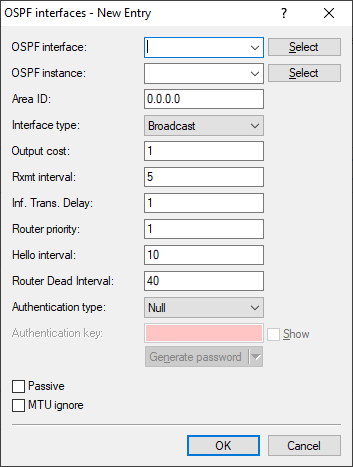Defines the interfaces on which OSPF should be operated.

- OSPF interface
- Contains the interface (IPv4 network or WAN remote site) on which OSPF is to be activated.
- OSPF instance
- Contains the name of the OSPF instance.
- Area ID
- Identifies the area by means of an IPv4 address.
- Port type
- Defines the interface type.Possible values:
- Broadcast
- Ethernet-based network; a default router is selected and multicast is used for communication.
- Point-to-point
- Network consisting of two routers only (e.g. GRE tunnel) or Ethernet via P2P link; no default router is selected and multicast is used for communication.
- Point-to-multipoint
- Network as hub-and-spoke topology; a default router is selected and multicast is used for communication.
- Non-Broadcast Multi- Access (NBMA)
- Point-to-multipoint networks that do not support broadcast or multicast; a default router is selected and unicast is used for communication; the neighbors are configured manually.
- Output cost
- Specifies the cost to send a packet on this interface, shown in the link-state metric. The advertisement is implemented in router LSA messages as a link cost for this interface.Note: The value must always be greater than zero.
- Retransmit interval
- Contains the number of seconds between retransmissions.
- Transmit delay
- Contains the estimated number of seconds required to transfer a link-state update packet over this interface.
- Router priority
- Defines the priority of this router on this interface when set as the designated router (DR). The router with the highest priority is set as the default router.Note: The value 0 prevents the router from becoming default router on this interface.
- Hello interval
- Contains the interval in seconds in which the router sends Hello packets from this interface.
- Router Dead Interval
- Specifies the elapsed time in seconds during which at least one hello packet must be received from a neighbor before the router declares that neighbor as down.Note: This value must be greater than the Hello interval.
- Authentication type
- Contains the authentication method to use for this interface.Possible values:
- Null
- Simple password
- Cryptographic MD5
- Authentication key
- Contains the authentication key for this network.Note: In this case the authentication type Null may not be selected.
- Passive
- Defines whether OSPF should work actively or passively on this interface.Possible values:
- Yes
- No routing updates or hello packets are sent from this router on this interface. Similarly, no incoming OSPF messages are processed either. However, the corresponding route or network of this interface is still inserted into the LSDB and so is advertised on other interfaces.
- No (Default)
- MTU ignore
- Disables the MTU value check in database description packets.Note: This allows routers to establish a full neighbor relationship even if the MTU of the corresponding interfaces is not uniform.
